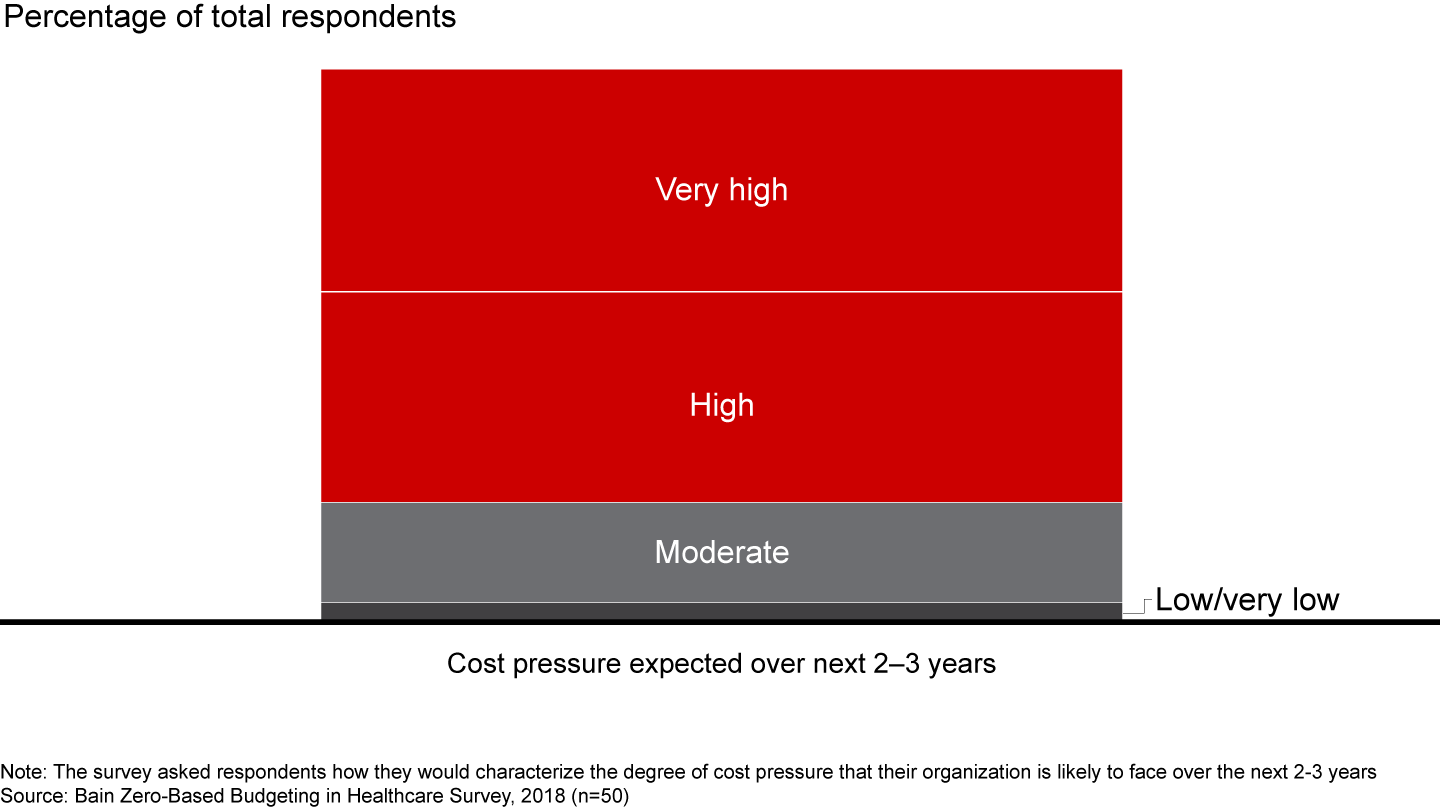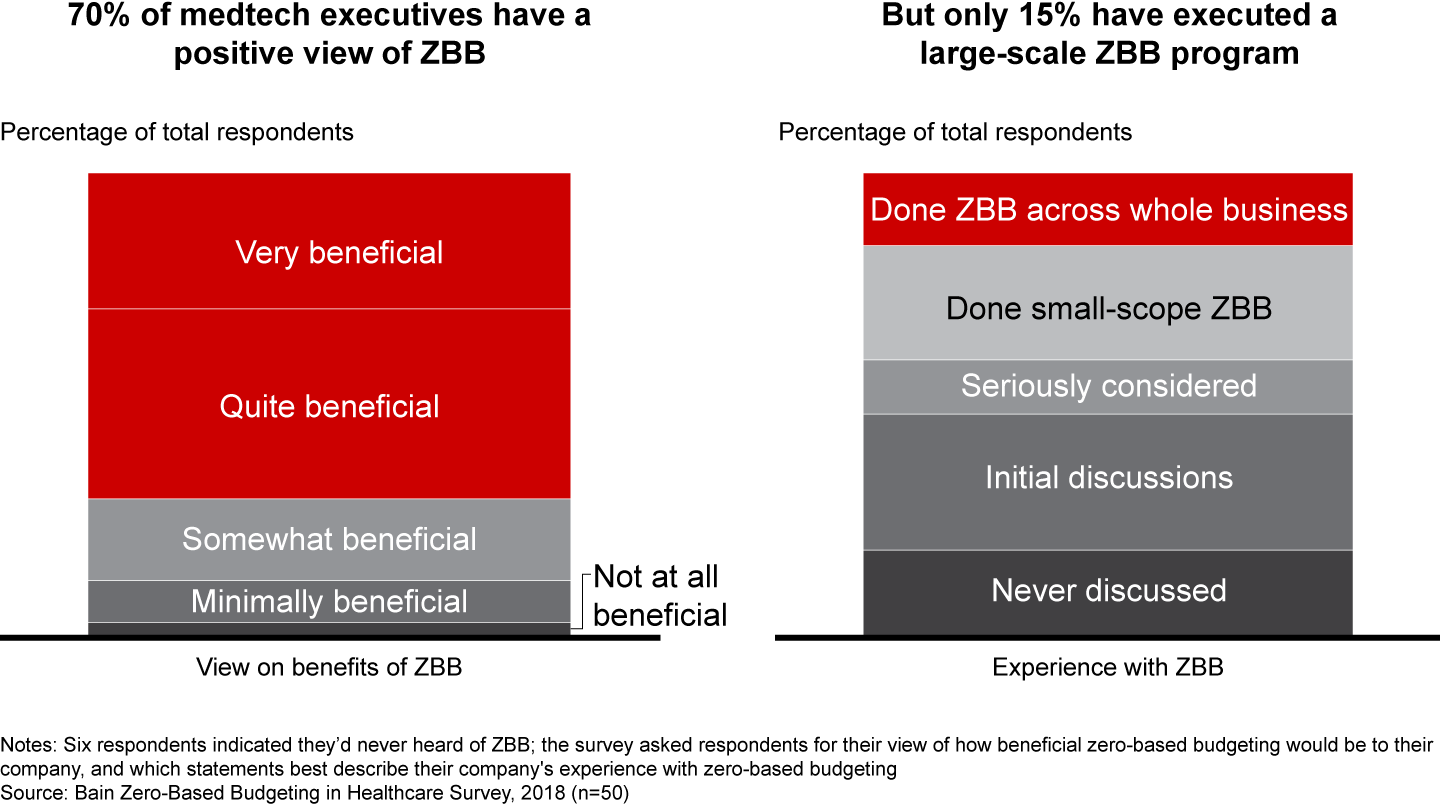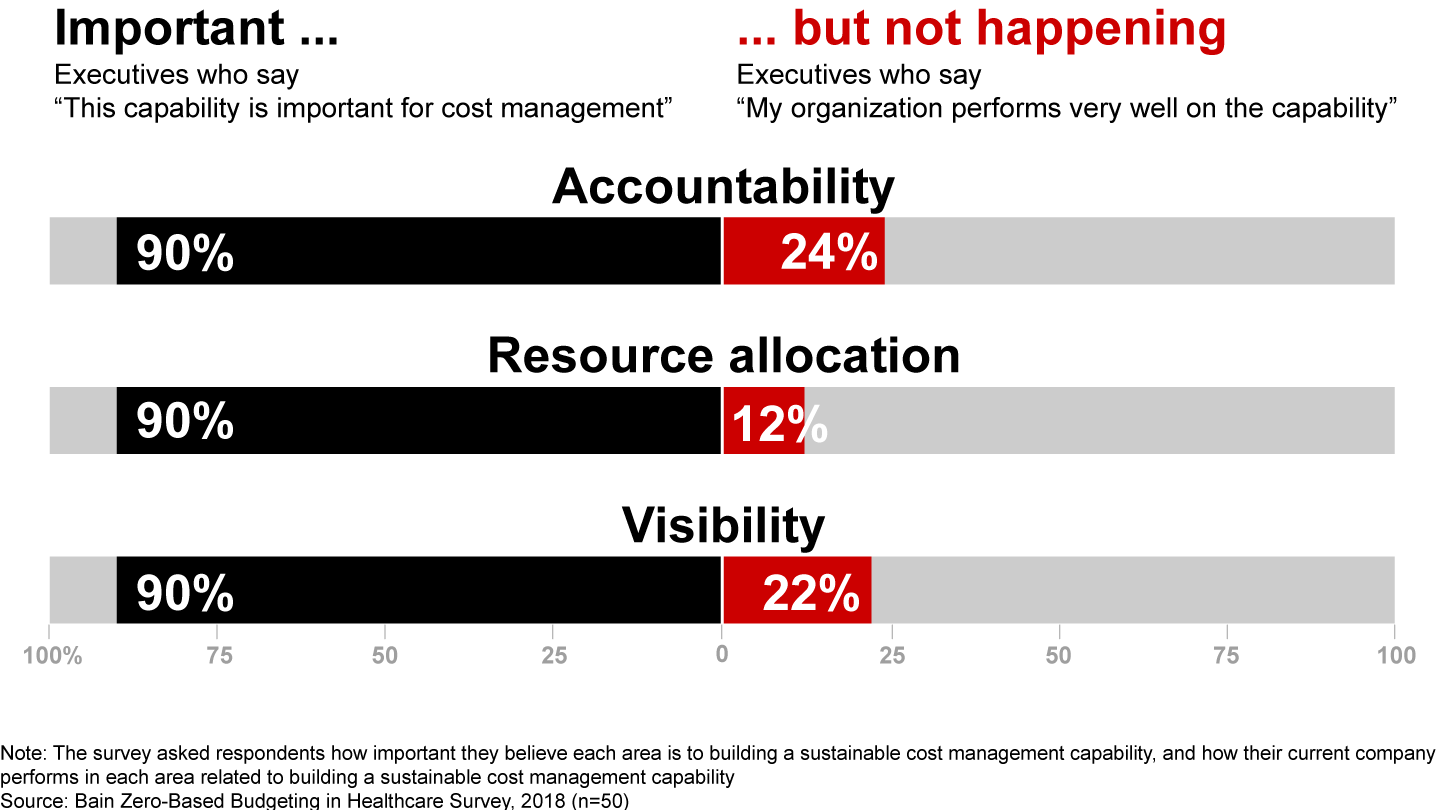Brief

Резюме
- Medtech leadership teams have a positive view of zero-based budgeting (ZBB), but few deploy it.
- ZBB is more than a cost-cutting tool; it’s a major shift in cost-management philosophy.
- To get the best results, successful companies customize ZBB programs to their organization’s culture.
For medtech companies, the battle to cut costs is about to get even more intense. A recent Bain & Company survey shows 80% of medtech executives say they expect to face “high” or “very high” cost pressure in the next two to three years as the industry adapts to changing market conditions (see Figure 1). The consolidation of hospital networks and professionalization of purchasing teams are just two of the trends putting pressure on prices.


Those changes are prompting many companies to consider a more radical approach to cost management—zero-based budgeting (ZBB)—which can deliver up to 25% in cost savings when implemented broadly across an organization. Yet despite those potential gains, medtech companies have been slow to deploy it. Bain research shows 70% of medtech executives familiar with ZBB view it favorably, but only 15% report having implemented a large-scale program across their companies (see Figure 2). Executives who are hesitant to deploy ZBB say they worry about complexity and sustainability and are unfamiliar with how the tool works.


It’s true that leadership teams often misunderstand zero-based budgeting. Companies that reap significant cost savings, in our experience, know ZBB is not a mere cost-cutting tool but a major shift in cost-management philosophy. The goal of a zero-based budgeting effort is a high-performance culture with an ownership mindset. It’s the difference between going on a crash diet to shed a few pounds and committing to lifestyle changes that improve your overall health, losing weight in the process.
Why is it so effective? Zero-based budgeting offers leadership teams vastly improved visibility and accountability. It helps them see exactly what is being spent and who is spending it, and the day-to-day activities that generate costs. Those insights are a huge advantage for medtech companies, which traditionally have had difficulty tracking their spending, given their global reach and multitude of business units with separate P&Ls competing in different therapeutic areas. Although 80% of medtech companies have undertaken major cost programs over the past five years, only 10% reported achieving all of their goals, according to Bain’s 2018 Zero-Based Budgeting in Healthcare Survey.
A key reason for the poor track record, medtech executives say, is the lack of spending visibility and accountability. For example, companies may assign significant portions of the budget to catchall accounts such as “other SG&A,” making it difficult to analyze them; or they may sprinkle related costs across many different budgets and general ledger codes, so it’s hard to obtain an integrated view of spending. Our research shows only 24% of executives feel that their organization performs “very well” on offering them spending accountability, and less than 12% feel that way about how their organization allocates spending (see Figure 3).


Zero-based budgeting holds individuals accountable for achieving savings in a cost category that spans business units, functions and geographies. It’s an opportunity to rethink all activity in the organization and ensure every dollar spent is working to support the company’s strategy and growth. For medtech companies, that includes freeing up critical capital to increase investment in high-priority R&D projects. At the same time, it builds the organizational muscle for continuous cost improvement.
To get the best results, successful companies customize ZBB programs to their organization’s culture. They determine the scope of the program based on the degree of change they are seeking and organizational readiness. They also decide which elements to manage centrally and ensure strong global category owners strike the right balance in collaborating with budget owners. Finally, leaders decide on incentive systems and the level of granular visibility they want in the budget. Companies don’t need to start with a full-throttle approach; they can install the capabilities and accelerate over time.
The companies that succeed with zero-based budgeting follow four guidelines:
Make it a top management priority. Leadership teams align on the bold mission first and make the case for change. ZBB is less about cost cutting than developing a high-performance culture. They build deep commitment at all levels of the organization before launching a ZBB program. The CEO, CFO and senior executives make it clear to all that ZBB is not a mechanical cost-cutting financial tool, but a new approach to cost management that changes the way the organization views spending.
Focus on strategic costs vs. nonstrategic costs. Many associate ZBB with across-the-board cutting. That’s a misconception and the wrong starting point. Zero-based budgeting helps a company distinguish between strategic and nonstrategic costs. The goal is not to slash spending, but to rethink and rebalance how the company spends every dollar so it supports investment priorities.
Link savings to growth. Too often, companies overlook the most strategic aspect of zero-based budgeting—rechanneling savings to fuel growth. That kindles employee engagement and an ownership mindset—both help ensure a ZBB program is successful. Ultimately, a well-designed zero-based budgeting program simplifies the organization and eliminates the clutter that makes it hard for employees to do their jobs, liberating high-performers.
Pave the way for behavior change. Even when companies strive to craft an effective ZBB program, they may stumble in executing it. One common pitfall is focusing on the tools, benchmarking and pace of the rollout, as opposed to training people in a new set of behaviors. Tools improve financial visibility only if managers and the front line use them to change the way they manage costs.
Zero-based budgeting is a powerful tool when companies understand what it is and what it is not. Companies that view ZBB as a program to “install”—an effort more about process than people and culture—are likely to be disappointed. Winners see it as a new capability that requires culture change and ongoing support from leadership teams. That distinction helps them deliver a triple win: higher revenues, stronger margins and improved employee engagement.
Patrick O’Hagan is a partner with Bain in the Boston office. Jason Evers is a partner with Bain & Company and is based in the Chicago office. Coleman Radell is a partner in the firm’s Los Angeles office. Dieter Meyer is a partner with Bain in the Zurich office. Jason, Patrick and Dieter work with the firm’s Healthcare practice. Coleman works with Bain’s Performance Improvement practice.